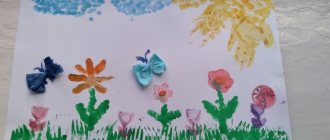Lesson notes for the middle group “Who is an artist?”
What feelings does the painting evoke?
Are you happy or sad looking at her?
What is the most important thing in the picture?
Describe the children's faces.
What did the artist V. Perov want to say with his work?
Educator:
Let us create our own work too! Let's think about what will be the main thing and how we can arrange the remaining objects so that we get a real picture. (The teacher conducts the didactic game “Make a Picture”)
Educator: Guys, do you think it’s difficult to be an artist? (Children's answers).
Educator:
Yes, to create their works, artists travel a lot, observe, and fantasize. Only then do they draw what they especially liked. Very often the artist does not have time for rest and entertainment. But you and I know that you need to take care of your health. If you are tired, you need to rest a little. I suggest doing exercises.
Physical education minute
I have always dreamed of becoming an artist, the gesture of dreaming, resting my head on my hand.
That's why I drew everywhere. Drawing in the air with an outstretched hand
.
With a pen on a piece of paper like this Drawing in the air with your hand, at chest level.
With a brush on the canvas like this Drawing in the air with your hand extended forward.
Pencil on the desk Drawing in the air with your hand, at chest level.
And chalk on the asphalt. Drawing in the air with your hand, at floor level
.
Boots on the snow, Foot drawing on the floor.
I skate on the ice with skates. Drawing on the floor with your foot.
On the sand with a twig, Drawing in the air with an imaginary twig on the floor.
On the board with a nail. Drawing in the air with an imaginary nail.
Educator:
To make the painting truly beautiful, the artist, like a real wizard, selects colors and mixes them. Let us also try to mix paints and get new shades. But we will do this not on a palette, but in magic jars. (The teacher conducts an experiment “Mixing colors”).
Educator:
But to paint a picture, the ability to mix paints is not enough. An artist must be able to peer into the world around him, listen in order to notice everything and draw beautifully. Then the lines, dots and spots will create real magic. See what can come out of ordinary lines, dots and spots. (The teacher shows and explains drawing from a spot, line, point).
Educator:
And now I will touch each of you with my brush and turn you into real artists. (The teacher touches each child with a brush, calling his name).
Educator:
Now, like real artists, you can draw your own miracles. Take your materials and turn the shapes on your sheets into something fabulous and unusual. And when you finish your work, we will all try to guess what you did together. (Music plays. Children draw on their own, the teacher helps children who have difficulties with guiding questions.).
Conversations about art
Practical task: waxography
Topic 2.6. Means of expression of decorative and applied arts
Lesson 1
Introduction to the expressive means of decorative and applied art: the unity of usefulness and beauty. The most ordinary household items, such as dishes, can also be works of art and bring benefits. The material from which the object is made plays a big role: the softness, plasticity of clay, transparency and fluidity of glass, smoothness and coldness of the metal and how well the master conveyed these properties. Samples of Aegean ceramics, Gzhel, Venetian glass, vessels from Festus, Zhostovo trays, etc.
Lesson 2
Unity of form and material in dpi. DPI items can be decorated with paintings or stucco patterns, sculptures. The decoration must correspond to the shape of the item, its purpose and the material from which it is made. The master uses the natural properties of the material, for example, a duck ladle, a black-figure kylix, a red-figure amphora, Tagil painted trays, Chinese painted porcelain, Vologda lace, etc.
Topic 2.7 . Features of fine art materials
Lesson 1
Sculpture materials. Variety of sculptural materials. Granite is a hard, dense stone. The granite sculpture is distinguished by the integrity of its volume, its character is calm and stern. S. D. Merkurov monument to K. A. Timiryazev, portraits of famous people. Marble is a soft, slightly translucent stone. Sublime, spiritualized images are embodied in marble. Michelangelo's Pietà, works by Scopas, Praxiteles, Roman sculptural portraits. Clay is a plastic, docile material; models and sketches of sculptures are made from it. Fired clay with a rough surface – terracotta (Clodion “Girl with a Child”). Glazed clay with a smooth, shiny surface – earthenware (L. Dela Robbna “Boy with a Garland”). Bronze - strength, elasticity, flexibility and mobility of molten metal give the sculptor great opportunities for composition. "Poseidon" 5th century. BC e., Verrocchio “David”, Barry “The Panther and the Antelope”, E. M. Falconet monument to Peter I. Longitudinal fibers are always visible in the wood, and the lines along which the sculptor’s chisel moves and where they intersect, a sharp break in the form occurs. Therefore, a wood sculptor always takes this feature into account. Egyptian wooden sculptures – “Priest Amenhotep”, “Scribe Kaya”; V. I. Mukhin’s portrait of academician A. N. Krylov, S. T. Konenkov “Old Field Man”.
Lesson 2
Variety of artistic painting materials. The choice of material depends on the artist’s intention. If an artist paints a picture directly on a wall, he often chooses the fresco technique. Paints for this type of work are diluted with water and applied to wet plaster. This painting is very durable and looks natural and beautiful on the wall. Raphael, Stanzas; Michelangelo, fragments of the Sistine Chapel painting. Before the oil painting technique, artists painted on boards with paints to which they added eggs or plant juices. Such paints are called tempera. A. Rublev “Trinity”; icon of the Rostov-Suzdal school of the 16th century. “The Miracle of Dmitry of Thessalonica; Simone Martini "The Annunciation". The development of oil painting techniques is associated with the names of the Van Eyck brothers, Dutch painters of the 15th century. Oil can be used for both quick sketches and longer works. The surface of the painting can be smooth (F. Vasiliev “Wet Meadow”), or it can be rough and uneven (M. Vrubel “Girl against the background of a Persian carpet”; C. Monet “Rouen Cathedral.” Individual strokes can merge or imperceptibly transform into friend (T. O. D. Ingres “Self-Portrait”), or can be clearly visible (Van Gogh “Road in Provence”) The effect of a space filled with light and air in oil technique is well conveyed by I. I. Shishkin “Noon. vicinities of Moscow", and real tangible objects in J.-B. Chardin's "Still Life".
Introducing middle school children to folk arts and crafts
Municipal Budgetary Educational Institution
"Kindergarten No. 129 "Antoshka"
“Introducing middle school children to folk arts and crafts”
Prepared by: Perminova A.V.
Target:
Formation and development of the foundations of spiritual and moral culture and aesthetic taste in children through familiarization with folk arts and crafts.
Tasks:
1. Introduce children to the Dymkovo and Filimonov toys as a type of folk decorative and applied art that has its own specificity and figurative expressiveness.
2. To form an idea of the craft of toy craftsmen, knowledge of what materials and tools the craftsmen use (to make toys you need: clay, a pottery wheel, a special stick or brush to draw a pattern, a kiln to fire the product, special paints for painting ).
3. Develop artistic and creative abilities in the process of perceiving works of decorative art and children's activities: drawing, modeling, appliqué.
INTEGRATION OF EDUCATIONAL AREAS according to the Federal State Educational Standard
Expanding your horizons in terms of fine arts and creativity.
Development of free communication with adults and children about the process and results of productive activities.
Formation of labor skills and abilities adequate to age, hard work in various types of productive activities.
Development of children's creativity, introduction to various types of art.
All work was carried out in three directions.
1) Introducing children to a certain type of folk arts and crafts. Emotional education of children: the ability to see, admire and admire the beauty of folk art objects, the formation of the need for “beauty”
.
Recognize familiar folk toys, their name, characteristic features, means of expression (pattern elements, their color, location on the form)
.
2) Introducing children to decorative drawing and appliqué based on authentic folk art objects. Introduction to some painting techniques. Make patterns on a strip, alternate one or two elements in shape, size, color. Make a symmetrical pattern on a square or circle, highlighting the border, corners, and middle.
3) Formation of children's decorative creativity. Selecting elements, their colors, then choosing paper, composition.
See on objects of each type of folk art the variability of elements, color combinations, and a variety of compositions.
Forms of organizing work with children.
1. Exhibitions
2. Virtual tour.
3. Artistic and creative activities to familiarize yourself with certain types of decorative and applied arts.

